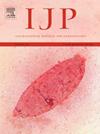Tangled communities: links between predation and parasitism through trophically transmitted digeneans in aquatic communities
IF 3.2
2区 医学
Q1 PARASITOLOGY
引用次数: 0
Abstract
Many trophically transmitted digeneans (Platyhelminthes: Trematoda) benefit from prey–predator interactions to complete the last step of their life cycles. These parasites use prey as second intermediate hosts and predators as definitive hosts. We expect a relationship between predation and life-history and community aspects of trophically transmitted digeneans. We hypothesise at species level: (1) host ranges of metacercaria and adult digeneans are positively related; (2) second-intermediate-host range of a digenean relies on prey breadth of its definitive hosts. At community level: (3) digenean species that share second intermediate hosts share definitive hosts; (4) modularity (i.e., community composed of subsets of frequently interacting species) and module affiliation (i.e., tendency of species to share interacting partners across different ecological networks) is high between predator–prey, second intermediate host-metacercaria and definitive host-adult parasite networks. We used data from metacercaria and adult digeneans, their hosts and predation among hosts from nine aquatic locations or replicates. We tested hypotheses (1–3) with richness and Rao diversity dissimilarities (Spearman and Mantel correlations, respectively). For hypothesis (4), we combined the three types of networks to evaluate the multilayer network modularity and module affiliation of the species that participate in different ecological process (predation, metacercaria and/ or adult infection). We found: (1) significant positive correlations between host richness of metacercariae and adults in seven out of nine communities (Spearman correlations p < 0.05). (2) The relationship between the second-intermediate-host range of metacercariae and the diet breadth of their definitive hosts varied between communities and depended on the specialisation degree of the digeneans. (3) Metacercariae sharing second intermediate hosts also shared definitive hosts as adults in seven communities (Mantel correlations p ≤ 0.05). (4) Communities were modular. Module affiliation varied from high to intermediate. Trophic ecology of definitive hosts provides a mechanistic understanding for the second-intermediate-host range and transmission pathways of trophically transmitted parasites.

缠结群落:水生群落中通过营养传播的线虫在捕食和寄生之间的联系。
许多营养性传播的digeneans (Platyhelminthes: Trematoda)受益于猎物-捕食者的相互作用来完成其生命周期的最后一步。这些寄生虫以猎物为第二中间宿主,以捕食者为最终宿主。我们期望在捕食和生活史之间的关系和社区方面的营养传播的digeneans。我们在物种水平上假设:(1)囊蚴和成年棘球蚴的宿主范围呈正相关;(2)地沟虫的第二中间宿主范围取决于其最终宿主的猎物宽度。在群落水平上:(3)共享第二中间寄主的地沟菌物种共享最终寄主;(4)在捕食者-猎物、第二中间宿主-包囊蚴和最终宿主-成虫网络中,模块化(即由频繁相互作用的物种子集组成的群落)和模块隶属关系(即物种在不同生态网络中共享相互作用伙伴的趋势)较高。我们使用了来自9个水生地点或重复的metacercars和成年digenenes,它们的宿主和宿主之间捕食的数据。我们用丰富度和Rao多样性差异(分别为Spearman和Mantel相关性)检验了假设(1-3)。对于假设(4),我们将三种类型的网络结合起来,评估了参与不同生态过程(捕食、metacercars和/或成虫感染)的物种的多层网络模块性和模块隶属关系。我们发现:(1)在9个群落中,有7个群落中囊蚴宿主丰富度与成虫呈显著正相关(Spearman相关性p
本文章由计算机程序翻译,如有差异,请以英文原文为准。
求助全文
约1分钟内获得全文
求助全文
来源期刊
CiteScore
8.40
自引率
2.50%
发文量
76
审稿时长
23 days
期刊介绍:
International Journal for Parasitology offers authors the option to sponsor nonsubscriber access to their articles on Elsevier electronic publishing platforms. For more information please view our Sponsored Articles page. The International Journal for Parasitology publishes the results of original research in all aspects of basic and applied parasitology, including all the fields covered by its Specialist Editors, and ranging from parasites and host-parasite relationships of intrinsic biological interest to those of social and economic importance in human and veterinary medicine and agriculture.

 求助内容:
求助内容: 应助结果提醒方式:
应助结果提醒方式:


